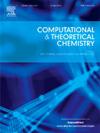First-principles study on the stability of different coordination structures of manganese (II) -pyrimidine complexes
IF 3
3区 化学
Q3 CHEMISTRY, PHYSICAL
引用次数: 0
Abstract
The oriented design of transition metal complexes is a cutting-edge topic in modern coordination chemistry, among which manganese (II) [Mn (II)] pyrimidine complexes have attracted much attention in the development of novel luminescent materials due to their low cost and high luminescence quantum yield. In this study, the unique stability mechanism of the N1 coordination isomer in 2-amino-4-methylpyrimidine-Mn (II) complexes is revealed for the first time by multiscale calculations. Existing Mn (II) - pyrimidine systems mostly focus on the tetrahedral configuration and luminescence properties, whereas systematic quantification of the selectivity of the ligand sites has not been reported. In this study, the stability of three coordination isomers (N1, N2 and N3) of Mn (II) complexes was investigated using first-principles calculations. Geometry optimisation results show that the N1 isomer has the lowest total energy (−837.38 eV) and its planar ligand configuration (dihedral angle 176.177°) effectively maintains the planarity of the π-conjugated system. Hirshfeld surface analysis reveals that the stability of N1 is due to the synergistic effects of strong ionic bonding (Mn - Cl, 4.9 %), oriented π-π stacking (C···C, 4.6 %) and a dense hydrogen bonding network (N - H···N, 10.9 %). It is emphasised that in complex systems the overall structural integrity can easily outweigh the enthalpic contribution of individual stronger coordination bonds. Electronic structure calculations show that the indirect bandgap of N1 is 1.7975 eV (5.8 % deviation from the experimental value), the conduction band/valence band k-space separation is related to the 400 nm Stokes shift phenomenon, the Mn - 3d orbital spin splitting (1.8 eV) dominates the band-side state distribution, and the symmetric hybridisation of the C/N - 2p orbitals promotes the carrier precipitation. These findings establish the design principle of "ligand symmetry-orbital hybridization", which provides a new strategy for the development of highly efficient manganese-based phosphorescent materials; the multi-scale framework (structure optimization → surface analysis → electronic calculations) is universal in transition metal complex engineering, which provides a quantitative pathway for the development of manganese-based materials in fields such as bioimaging and optical communications.

锰(II) -嘧啶配合物不同配位结构稳定性的第一性原理研究
过渡金属配合物的定向设计是现代配位化学的前沿课题,其中锰(II) [Mn (II)]嘧啶配合物因其成本低、发光量子产率高而在新型发光材料的开发中备受关注。本研究首次通过多尺度计算揭示了2-氨基-4-甲基嘧啶- mn (II)配合物中N1配位异构体的独特稳定性机制。现有的Mn (II) -嘧啶体系主要关注四面体结构和发光性质,而对配体位点选择性的系统定量研究尚未见报道。本文采用第一性原理计算方法研究了Mn (II)配合物的三种配位异构体(N1、N2和N3)的稳定性。几何优化结果表明,N1异构体具有最低的总能量(- 837.38 eV),其平面配体构型(二面角176.177°)有效地保持了π共轭体系的平面性。Hirshfeld表面分析表明,N1的稳定性是由于强离子键(Mn - Cl, 4.9%)、定向π-π堆积(C··C, 4.6%)和致密氢键网络(N - H··N, 10.9%)的协同作用所致。强调的是,在复杂系统中,整体结构的完整性很容易超过单个更强的配位键的焓贡献。电子结构计算表明,N1的间接带隙为1.7975 eV(与实验值偏差5.8%),导带/价带k空间分离与400 nm Stokes位移现象有关,Mn - 3d轨道自旋分裂(1.8 eV)主导带侧态分布,C/N - 2p轨道的对称杂化促进载流子析出。这些发现确立了“配体对称轨道杂化”的设计原则,为开发高效锰基磷光材料提供了新的策略;多尺度框架(结构优化→表面分析→电子计算)在过渡金属复杂工程中是通用的,这为生物成像、光通信等领域锰基材料的发展提供了定量途径。
本文章由计算机程序翻译,如有差异,请以英文原文为准。
求助全文
约1分钟内获得全文
求助全文
来源期刊

Computational and Theoretical Chemistry
CHEMISTRY, PHYSICAL-
CiteScore
4.20
自引率
10.70%
发文量
331
审稿时长
31 days
期刊介绍:
Computational and Theoretical Chemistry publishes high quality, original reports of significance in computational and theoretical chemistry including those that deal with problems of structure, properties, energetics, weak interactions, reaction mechanisms, catalysis, and reaction rates involving atoms, molecules, clusters, surfaces, and bulk matter.
 求助内容:
求助内容: 应助结果提醒方式:
应助结果提醒方式:


